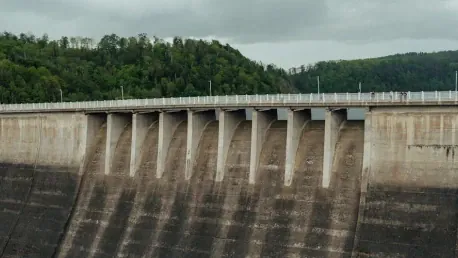The U.S. Department of Energy (DOE) has recently committed nearly $15 million to fund nine research and development projects designed to enhance the capabilities of hydropower facilities. These initiatives aim to improve the response and flexibility of hydropower, making it more adept at meeting the dynamic demands of the electric grid. By doing so, the DOE seeks to ensure these facilities can effectively support the integration of renewable energy sources such as wind and solar power into the grid. With an increasing reliance on variable renewable energy sources, enhancing the adaptability and performance of hydropower is crucial for maintaining grid stability and reliability.
Enhancing Operational Flexibility
A key focus of the DOE’s investment is to increase the operational flexibility of hydropower facilities. By improving hydropower’s ability to quickly adapt to changes in electricity demand, the DOE seeks to bolster grid stability and reliability amidst the increasing incorporation of variable renewable energy sources. For instance, Cube Yadkin Generation’s project at the Tuckertown facility in North Carolina will create a “trihybrid” system by adding battery storage to an existing setup that includes solar photovoltaics. This combination aims to enhance the facility’s reliability and performance, making it more responsive to grid demands.
Another example is the Forks of Butte project by Synergics Energy Services in Magalia, California. This project includes a battery energy storage system to hedge against the financial impact of droughts while increasing project revenues. By integrating battery storage, these facilities can store excess energy generated during periods of low demand and release it during peak times, thus ensuring a more stable and reliable power supply. These advancements emphasize the importance of flexibility and resilience in modern energy systems, particularly as the grid becomes more dependent on intermittent renewable energy sources.
Integration with Other Technologies
Many of the funded projects involve the integration of hydropower with other forms of energy generation or storage technologies. The DRG Technical Solutions project in Manitou Springs, Colorado, aims to combine hydrogen production technologies with existing hydro facilities. The produced hydrogen can be stored and used to generate electricity or fuel vehicles as needed. This dual-purpose facility can provide a versatile energy solution that supports both electricity generation and transportation needs.
Similarly, the GE Vernova initiative aims to develop polymer-based add-ons for turbines to enhance the operational range and efficiency of hydropower facilities under a wider range of conditions. These technological advancements can help existing hydropower plants operate more efficiently without extensive overhauls, thereby extending their functional capacity and contributing to grid stability. By integrating hydropower with other innovative technologies, these projects aim to create hybrid systems that are more versatile and capable of meeting diverse energy needs.
Economic and Environmental Benefits
Investments in hydropower technologies also encompass economic and environmental considerations. By enhancing the resilience of hydropower facilities to handle financial and environmental unpredictability, these projects can provide significant economic benefits. For example, the Forks of Butte project not only aims to increase project revenues but also to mitigate the financial impact of droughts, which can severely affect hydropower generation. Such measures ensure the financial viability of hydropower projects even under challenging conditions.
Moreover, the integration of renewable energy sources with hydropower can lead to substantial environmental benefits. By supporting the stable and reliable incorporation of renewable energy sources into the nation’s power grid, these projects can reduce reliance on fossil fuels and lower greenhouse gas emissions. This comprehensive approach underscores the crucial role of hydropower in a rapidly evolving energy landscape, emphasizing its potential to stabilize the grid while facilitating the broader adoption of renewable energy. The projects reflect a concerted effort to modernize and expand hydropower capabilities, ensuring its continued contribution to a cleaner, more sustainable energy future.
Optimization and Advanced Modeling
Several projects are focused on optimizing hydropower operations through predictive modeling and artificial intelligence. The University of California, Irvine’s HydroFlex project aims to develop an open-source tool to integrate hydropower resources with solar, wind, and storage. This tool can help operators make informed decisions about when to generate and store energy, thereby optimizing the use of available resources. Meanwhile, the Missouri University of Science and Technology will leverage AI for better forecasting and operational adjustments.
By using machine learning to analyze data and predict future conditions, these projects can help hydropower operators optimize their operations for greater grid resilience and sustainability. This advanced modeling can also support market participation by helping operators forecast and adapt to changing conditions, ensuring a more stable and reliable power supply. The use of AI and other advanced technologies represents a significant step forward in the modernization of hydropower, making it a more integral part of the renewable energy mix.
Capacity to Manage a Variety of Conditions
The U.S. Department of Energy (DOE) recently pledged nearly $15 million to support nine research and development projects aimed at boosting the capabilities of hydropower facilities. These efforts are focused on improving the responsiveness and flexibility of hydropower systems, making them better suited to meet the fluctuating demands of the electric grid. As the DOE seeks to incorporate more renewable energy sources like wind and solar power into the grid, enhancing the versatility and performance of hydropower becomes essential. With the growing dependence on variable renewable energy sources, strengthening hydropower’s adaptability is key to ensuring the grid remains stable and reliable. This funding not only supports technological advancements in hydropower but also plays a vital role in the broader transition toward a more sustainable energy future. By enhancing hydropower’s capabilities, the DOE aims to create a more resilient and efficient power system that can better integrate renewable energy, ultimately contributing to a cleaner, greener, and more reliable energy landscape for the United States.









